|
|
|
| |
|
|
|
Nonindigenous Species |

|
Invasion by nonindigenous species is one of the most important issues in natural resource management and conservation biology today. The ability of nonindigenous species to alter population, community, and ecosystem structure and function is well documented (Elton 1958; Mooney and Drake 1986; Vitousek et al. 1987; Drake et al. 1989). Ecosystem-level changes that alter water, nutrient, and energy cycles; productivity; and biomass directly affect human society. Ecosystem-level consequences of invasive nonindigenous species have major ecological and economic implications and directly affect human health. Complex technology has addressed the cleanup of chemical pollutants and contaminants and has reversed some of the damage from physical alteration of the environment. However, little attention has been paid--and almost no progress has been made--in addressing the problem of nonindigenous species.
|
The problem of biological invasion of the United States is not new. In the continental United States, it began with the arrival of the first European settlers more than 500 years ago and has continued at an increasing rate. In Hawaii, it began more than a thousand years ago with the arrival of the Polynesians, who introduced several plants into their new landscape. Many of the early introductions of plants and animals were intentional and generally viewed as a welcome enrichment of the American biota. Among early introductions were the domesticated animals and plants, which were essential to the survival of settlers as dependable sources of food and fiber. As invasive nonindigenous species have increased and their effects on native biota have become apparent, the perception about many introductions has shifted from welcome additions to pests. Today, although the economic and recreational benefits of selected nonindigenous species are considerable, evaluation of the economic and ecological costs reveals that introductions of nonindigenous species can also be expensive. The nonindigenous species problem has reached proportions that demand development of a coherent national policy to guide future actions.
|
Definitions of invasive nonindigenous species have been inconsistent, leading to confusion in lay and scientific literatures. First, the distinction between natural biological invasions, which are generally considered as range expansions, and introductions involving human activities is important. Exotic, alien, transplanted, introduced, nonindigenous, and invasive are words that have been used to describe plants and animals that were moved beyond their native ranges by humans. For consistency, we adopted the definition from the Nonindigenous Aquatic Nuisance Prevention and Control Act of 1990 (Public Law 101-646, 16 USC 4701-4741, approved 29 November 1990), which defines nonindigenous species as, "The condition of a species being moved beyond its natural range or natural zone of potential dispersal, including all domesticated and feral species and hybrids." This definition embodies the most critical biological aspect of nonindigenous species--the movement or introduction of a species beyond its native range by humans. Some resource managers have used political boundaries, such as state or national borders, as a standard to determine the status of an introduction (Shafland 1986); however, they did not consider that species moved beyond their native ranges within state boundaries or within the United States (for example, from the east coast to the west coast) as nonindigenous species. Regardless, ecosystems receiving nonindigenous introductions respond based on a suite of biological and ecological interactions irrespective of the political boundaries from which the species originated. Today, many biologists recognize that any species moved beyond its native range by human activities is a nonindigenous species, and they realize that when such an action is taken, it is hazardous to the economic and ecological foundations of the country (Office of Technology Assessment 1993).
|
| |
|
|
|
This continued homogenization of the world's flora and fauna, which represents at least millions of years of separate evolutionary histories, is an ecological holocaust of major proportions. In examining the ecological interactions of invasive nonindigenous animals and plants with native biotic communities, the introductions of nonindigenous species seem tantamount to an ecological surprise attack. The invaded community does not recognize the nonindigenous species that arrived in its midst and often has few or no natural controls to prevent establishment of the invader. Evolution of biotic communities in the absence of ecological interactions with a particular introduced organism may result in reduced resistance to the invasive nonindigenous species.
|
|
|
An examination of the origin of nonindigenous species introductions helps us understand the problem. Nonindigenous species can be divided into three categories: intentional introductions, intentional introductions with subsequent escape, and unintentional introductions. Intentional introductions are those nonindigenous species transported beyond their native range and released into the wild with the purpose and intention that they will become established; these include the house sparrow and the common carp. Intentional introductions with subsequent escape are those nonindigenous species transported beyond their native range under captive conditions and which subsequently escape into the wild, where they may establish reproducing populations; these include aquarium fishes and the African clawed frog. Unintentional introductions are those nonindigenous species that are transported, usually unnoticed or without detection, beyond their native range in the course of some unrelated activity; these include zebra mussels in ballast water or imported red fire ants on cattle boats.
|
|
|
Recognition of these three categories is important for the analysis of pathways used by invasive nonindigenous species. Intentional introductions have been made for a variety of purposes such as ornamental plants, food crops, livestock, game, pets, and biological control. Subsequent to their establishment, some intentionally introduced organisms escaped or were released and became harmful pest species. Some of the most harmful nonindigenous plants, including kudzu, saltcedar, and water hyacinth, were intentional introductions that subsequently escaped from confinement. The common carp, European starling, and burro are examples of intentionally introduced animals that have harmed native biota (Office of Technology Assessment 1993).
|
|
|

Unlike most intentional introductions, which are chosen for a suite of desirable traits, unintentional introductions were not selected for beneficial characteristics. Pathways of unintentional introductions are varied and include agricultural products, cut flowers, timber, seeds, and potted plants. Other species that have been unintentionally introduced have sneaked in with packing materials, ballast water, military vehicles, and containerized freight. A review of 1,364 nonindigenous species revealed that only 22% of the intentional introductions were harmful, whereas 47% of the unintentional introductions were harmful. Evaluations of terrestrial vertebrates, fishes, and mollusks, however, revealed that harm from intentional and unintentional introductions was approximately equal (Office of Technology Assessment 1993; Fig. 1). For these groups, the criteria for the screening and evaluation process seem to have been inadequate to determine the risk from these intentional introductions. Management of most intentional introductions is possible by legislation. Prevention of unintentional introductions requires stringent measures, however.
|
Fig. 1. Percentage of harmful effects by intentional and unintentional introductions (total for both of 1,364 species) of various groups of nonindigenous organisms (Office of Technology Assessment 1993). |
Attributes of Invading Species and Invaded Communities |
|
Several questions are critically important for an understanding of invasive nonindigenous species and invaded communities. For example, do some characteristics make a species particularly subject to establishment and spread? Should some species cause more concern than others? Why is one ecological community more vulnerable to invasions than another community? Do rules exist by which the success or failure of a particular invasion may be predicted? Research is needed to answer such questions and to help us understand the phenomenon of species invasions, as well as to aid in the prevention or treatment of invasions.
|
|
|
Researchers generally agree that not all species are equally invasive and not all ecological communities are equally susceptible to being invaded (di Castri 1989). Although the ability of a particular nonindigenous species to successfully invade seems to be an individualistic phenomenon depending on the species and ecosystems, general patterns may aid in predicting the results of invasions. Not all introduced species succeed in becoming established. In fact, many fail, although failures are reported far less often than successes. Chance--or at least unknown factors--apparently plays a large role, because some intentional introductions failed several times before they succeeded (Office of Technology Assessment 1993). For example, most introductions of game birds into the United States--including seven species of pheasants, quails, and their relatives--failed initially and succeeded only under optimal circumstances (Pimm 1991). The European starling successfully colonized New York's Central Park in 1891, and then most of North America, only after several previous failed introductions (Long 1981).
|
|
|
Determining which nonindigenous species introductions may succeed or fail in a given situation requires a wealth of ecological knowledge about the organisms. For example, proposed introduction of a nonindigenous species should provide biological data indicating whether the species can tolerate the physical conditions of its new home, whether it can reproduce at its initial low densities, whether food in the new location is appropriate and plentiful, and whether predators, parasites, or pathogens will allow it to prosper.
|
|
|
|
Beyond these basic biological questions, though, are there species characteristics that lend themselves to greater likelihood of success as an invasive? That is, do successful invasive nonindigenous species tend to have certain characteristics in common that contribute to their success? In general, highly successful nonindigenous invaders seem to have one or more characteristics that further their establishment and expansions (Table 2). These, however, are merely generalizations, and exceptions are many. These characteristics do not guarantee that a particular nonindigenous invader will be highly successful, and the absence of most of the characteristics does not preclude the invasion of a species in a given circumstance. Also, different investigators focused on different characteristics depending on the taxonomic groups under investigation. For example, Ashton and Mitchell (1989) listed three significant factors for the success of invasive nonindigenous aquatic plants: vegetative reproduction, rapid rate of reproduction, and association with human activities that further expansion. Baker (1965:157) described a highly invasive nonindigenous plant (the ideal weed) as one which was "a plastic [i.e., adaptable] perennial which will germinate in a wide range of physical conditions, grows quickly, flowers early, is self-compatible, produces many seeds which disperse widely, reproduces vegetatively and is a good competitor." Lodge (1993) stated as general rules that most invasions fail, invaders with the highest probability of conspicuous success have a novel functional role such as top predator, and communities with a long history and a draw on a large species pool are most able to resist invasion. |
Table 2. Some generalized characteristics of successful invasive nonindigenous species. The list is not exhaustive, and not every characteristic applies to each species in every case (modified from Ehrlich 1989; Lodge 1993; Meffe and Carroll 1994).
| Characteristics of invaders |
| High rate of reproduction; pioneer species; short generation time |
| Long-lived |
| High dispersal rates |
| Single-parent reproduction (for example, a gravid or pregnant female can colonize) |
| Vegetative or clonal reproduction |
| High genetic variability |
| Phenotypic plasticity |
| Broad native range |
| Abundant in native range |
| Tolerant of wide range of conditions |
| Habitat generalist |
| Broad diet (polyphagous) |
| Gregarious |
| Human commensal |
|
| | |
Thus, many different perspectives pervade views of invasive nonindigenous species. In reference to the many rules of nonindigenous invaders that have been proposed, Brown (1989:86) stated that, "These rules are of limited utility in making specific predictions about the probability of establishment of a particular species in a certain region or habitat. This unpredictability is due to the uniqueness of species and places, which in turn is in large part a consequence of their distinct histories." The success of invasive nonindigenous species is highly variable, and predictability of invasions is limited in spite of well-established general patterns of invasions (Office of Technology Assessment 1993).
|
|
What are the characteristics of a community that is successfully invaded by plants or animals? Like species, ecological communities have characteristics that promote invasion by organisms (Table 3). One of the most important features that makes a community susceptible to invasion by nonindigenous species is the level of human-induced disturbance (Hobbs 1989). A disturbed state is a common feature of invaded communities and seems to provide opportunities for the invasion of many nonindigenous species. For example, the ability of nonindigenous fishes in the American Southwest to invade riverine ecosystems is greatly enhanced by disturbances stemming from dams, water diversions, destruction of riparian habitat, and other factors (Minckley and Deacon 1991). Few or no nonindigenous species reside in the few remaining free-flowing streams, and nonindigenous species that do colonize these streams are usually washed out of the stream by natural flooding (Meffe 1984; Minckley and Meffe 1987). Likewise, imported red fire ants are most successful in disturbed areas such as roadsides and agricultural fields and rarely penetrate intact, closed forests (Frank 1994). Similarly, kudzu invades from the disturbed edges of forests and from roadsides, where light availability is greater than in the interior forest (Schmitz 1994). Nonindigenous birds such as European starlings and house sparrows do well in disturbed areas such as cities, suburbs, and farms. In general, human disruptions of natural communities, such as by soil alterations, removal of vegetative cover, or suppression of natural disturbance regimes, seem to promote the invasion of a community by nonindigenous species. The invasion of intact communities may be more difficult. |
Table 3. Generalized characteristics of communities more likely to be invaded by nonindigenous species (from Meffe and Carroll 1994; modified from Lodge 1993).
| Characteristics of communities |
| Climatically similar to original habitat of invader |
| Early successional (recently disturbed) |
| Low diversity of native species |
| Absence of predators on invading species |
| Absence of native species morphologically (form or structure) or ecologically similar to the invader |
| Absence of predators or grazers in evolutionary history (naive prey) |
| Absence of fire in evolutionary history |
| Low-connectance food web |
| Disturbed by humans |
|
|
| | |
The separation of the effects of disturbance from other features that allow or promote species invasions is difficult because of the absence of controls for comparisons with the disturbed sites. Whether a disturbance or other factors promoted or permitted the colonization and expansion of a nonindigenous species often cannot be determined. Because most of the world is disturbed by humans, the question may be moot anyway. If disturbed ecosystems are indeed more likely to be invaded, then nearly the entire world is being made an easier target for invasive nonindigenous species. The presence of nonindigenous species is a disturbance that further alters an ecosystem, perhaps promoting colonization by still other nonindigenous species. For example, a nonindigenous grass that inhibits germination of native trees makes the community more vulnerable to invasion by other nonindigenous grasses. In turn, a disturbed ecosystem may offer better opportunities for nonindigenous, grass-eating insects, which further perturb the community, making invasion of other nonindigenous species more likely, and so on. Disturbance and nonindigenous species interact in complicated ways, but usually to the detriment of native community structures.
|
|
Brown (1989) presented five rules of biological invasions that are broad generalizations about the conditions under which nonindigenous invasions may succeed (Table 4). These rules, he believed, are broadly applicable to vertebrates, invertebrates, and plants. Of vital importance among these rules is the ecological isolation of the invaded habitat, which seems to be critical to its vulnerability to invasion by nonindigenous species. It also helps if the physical characteristics of the new environment are similar to those in the native environment of the invasive nonindigenous species and if other species are not present in similar niches of the invaded habitat. Finally, disturbance and close association with humans are common characteristics of a community that is vulnerable to invasion by nonindigenous organisms. |
Table 4. Five generalized rules for the potential success of a biological invasion (from Brown 1989).
| |
Generalized rules |
| Rule 1 |
Isolated environments with a low diversity of native species tend to be differentially susceptible to invasion |
| Rule 2 |
Species that are successful invaders tend to be native to continents and to extensive, nonisolated habitats within continents |
| Rule 3 |
Successful invasion is enhanced by similarity in the physical environment between the source and target areas |
| Rule 4 |
Invading nonindigenous species tend to be more successful when native species do not occupy similar niches |
| Rule 5 |
Species that inhabit disturbed environments and those with a history of close association with humans tend to be successful in invading human-modified habitats |
|
|
| | |
Do the same rules apply to terrestrial and aquatic nonindigenous species, or do the ecosystems function differently? Differences in the modes or patterns of invasion of terrestrial and aquatic ecosystems by nonindigenous species are not consistent. The general characteristics of a successful invader or a community that is vulnerable to invasion by nonindigenous species exist regardless of the nature of the community. For example, single-parent reproduction is as advantageous in colonizing a new habitat for a pregnant rodent or lizard as it is for a pregnant livebearing fish in a new lake. High dispersal rates and broad diets are advantageous on land or in water, as are high rates of reproduction once colonization is realized. Likewise, characteristics of communities that are vulnerable to invasion by nonindigenous species are equally beneficial to the invaders on land and in water. For example, one would expect the absence of predators of the nonindigenous species or a low diversity of native species to equally promote invasion. Some disturbance events occur in only certain ecosystems, but the general rules (Tables 2, 3, and 4) apply to any type of ecosystem.
|
|
|
Loss of Biodiversity and Ecosystem Changes Due to Invasions |
|
When biodiversity is defined to include only the genetic, species, and ecosystem diversity native to an area, then invasive nonindigenous taxa clearly degrade biodiversity. However, frequent inclusions of species from any place of origin render a misleading and inflated measure of biodiversity. Measurements of biodiversity should include only native species. When the addition of nonindigenous species causes losses of native species, it causes a net loss of biodiversity and a degradation of the ecosystem.
|
|
|
|
One of the major effects of invasive nonindigenous species on biodiversity is outright loss of native species (Nott et al. 1995); this is a common and repeated pattern after establishment of nonindigenous species occurs. Invasive nonindigenous species are known to have caused the extinction of at least 109 vertebrate species around the world (Cox 1993), a significant proportion of overall identified causes of extinction of vertebrates (Table 5). In Hawaii, nonindigenous species introduced as biological-control agents have been implicated in extinctions of 15 native (endemic) moth species (Howarth and Ramsay 1991). The unintentional introduction of the brown tree snake caused the extinction of five species or subspecies of birds on Guam and significant declines of many other species (Savidge 1987). In Arizona, a pupfish endemic to a single spring became extinct within 1 year when largemouth bass were introduced to its sole habitat (Minckley 1973). |
Table 5. Major known causes of vertebrate extinctions around the world (modified from Cox 1993).
| Group |
Human exploitation |
Invading species |
Habitat disruption |
Other |
Unknown |
| Mammals |
24 |
20 |
19 |
1 |
36 |
| Birds |
11 |
22 |
20 |
2 |
37 |
| Reptiles |
32 |
42 |
5 |
|
21 |
| Fishes |
3 |
25 |
29 |
3 |
40 |
| Total number |
70 |
109 |
73 |
6 |
134 |
| Total % of known causes |
27.1 |
42.3 |
28.3 |
2.3 |
|
|
| | |
| |
|
|
|
Island species tend to be especially vulnerable to the effects of nonindigenous species. A review of worldwide animal extinctions since 1600 revealed that 75% were island species (Groombridge 1992). Hawaii and other Pacific Islands are infamous for their endemic species that have been driven to extinction by colonization of nonindigenous species (Office of Technology Assessment 1993). The nation's highest rate of nonindigenous species' invasions and native species' extinctions is in the Hawaiian Islands (see chapter on Pacific Islands). Hawaii receives more nonindigenous species annually than any other state and has the highest proportion of established nonindigenous species in the wild, the highest concentration of threatened and endangered species, and the highest number of extinct species (Office of Technology Assessment 1993).
|
|
|
Evolution in isolation has produced the high rate of endemism of island species and also has resulted in especially "naive" faunas and floras, that is, species that have not historically had to cope with many types of competitors or predators. These species are especially susceptible to the effects of invading nonindigenous species. Consequently, two-thirds of all plants and birds that have become extinct in the United States were from Hawaii (Opler 1976; Vitousek et al. 1987). The Hawaiian Islands have lost more than 50% of their native bird species, 50% of their plants, and 90% of their native land snails. Many of these extinctions are directly or indirectly due to nonindigenous species (Scott 1995).
|
|
|
An invasive nonindigenous species need not drive native species to extinction to have serious effects on the ecosystem (see box on American Chestnut Blight). Other effects include general decline in abundance of native species, change in ecosystem structure and function, and rearrangement of trophic relations.
|
|
|
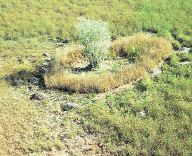
Some invaders displace native species. For example, several nonindigenous grasses in the American West suppress the seedlings of oaks, pines, and other native species. In Arizona, at least 10 native plant species declined in abundance because of the spread of African love-grass (D'Antonio and Vitousek 1992). Other invaders change basic ecosystem structure or
|
Fig. 2. Melaleuca seedlings encircle a dead adult Australian melaleuca tree. After the adult tree in the middle of the picture was treated with herbicides, the stressed tree released seeds, illustrating the difficulty of controlling exotic species.
© François Laroche, South Florida Water Management District |
dynamics. For example, zebra mussels decrease food availability for other filter feeders and increase light penetration by rapidly filtering and removing particles from water (Britton 1991). The Australian melaleuca tree has modified soil characteristics and topography of large areas of the Florida Everglades, displacing native vegetation and changing habitat structure for native wildlife (Schmitz 1994; Figs. 2 and 3). Saltcedar has similarly altered riparian ecosystem structure and water-flow patterns in desert streams of the southwestern Great Plains and Southwest (Loope and Sanchez 1988). Feral hogs throughout the Southeast, California, Hawaii, and the Great Smoky Mountains National Park trample, uproot, and destroy native vegetation, changing understory structure and displacing leaf litter and soil organisms (Peine and Farmer 1990). Aquatic equivalents are the grass carp and common carp, which destroy aquatic vegetation, increase water turbidity, and destroy habitat for smaller fishes (Moyle et al. 1986). The list could go on and on.
|
Fig. 3. In 1965 this square-mile section in Dade County, Florida, was composed almost entirely of native sawgrass prairie, a native habitat, with only a few Australian melaleuca trees. By 1990, however, melaleuca had almost entirely eradicated the original sawgrass prairie. © François Laroche, South Florida Water Management District. |
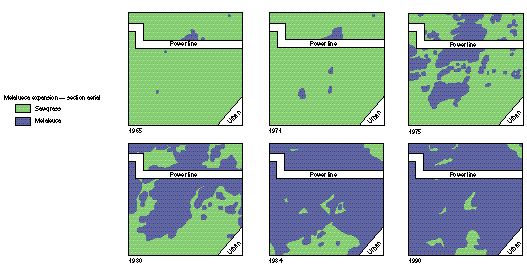
|
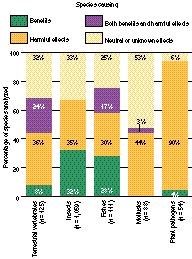
In some cases, the effects of an invasive nonindigenous species have cascaded throughout an ecosystem's food web. One of the best-known examples is the introduction of opossum shrimp into Flathead Lake, Montana. Heavy feeding by shrimp caused populations of zooplankton to drop, which in turn greatly reduced populations of forage fishes, which caused declines in predators such as bald eagles, river otters, bears, and coyotes (Spencer et al. 1991). Overall, harmful effects generally outweigh any beneficial effects of invasive nonindigenous species in the United States (Fig. 4).
|
Fig. 4. Percentage of nonindigenous species that cause beneficial, harmful, both beneficial and harmful, and neutral or unknown effects (Office of Technology Assessment 1993). |
Threats to Parks and Endangered Biota |
|
Federal parks and natural areas account for about 3% of the total land area of the United States. An additional 27% of the land is managed by federal agencies such as the U.S. Bureau of Land Management, the U.S. Forest Service, the U.S. Fish and Wildlife Service, and the Department of Defense for a variety of purposes, but most land remains largely in an undeveloped state. While lands in public ownership are critical to efforts to maintain biodiversity, all suffer, to varying degrees, from invasive nonindigenous species. The National Park Service manages its lands with an aggressive policy to control or remove existing nonindigenous species and prohibit establishment of new invaders. This policy extends to management of invasive nonindigenous species adjacent to park lands with the consent of private land owners. Parks frequently exist as islands of natural communities surrounded by a sea of disturbance, providing invasive nonindigenous species with excellent opportunities to move into protected areas.
|
|
|
Still, the number of nonindigenous species in national parks is increasing to the point that removal and control cannot keep pace with new invasions (Office of Technology Assessment 1993). Most problems from invasive nonindigenous species in parks involve nonindigenous plants, which is not surprising because more than half of all nonindigenous species in the
|
|
|
United States are plants. The large number of nonindigenous plants in each state (Fig. 5) is indicative of the problem in parks.
|
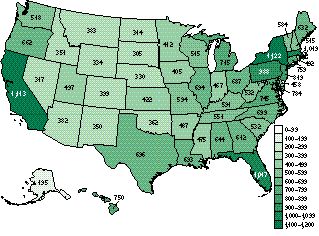
Fig. 5. Number of nonindigenous plant species (from outside the United States) introduced into each state (data on number of native and introduced species from a phytogeographic data summary in preparation by J. T. Kartesz, Biota of North America Program of the North Carolina Botanical Garden, Raleigh). |
Nonindigenous species are a major threat to endangered and threatened biota. Invasive nonindigenous plants and animals should be treated as biological pollutants that can, in the presence of physical habitat alteration or chemical pollution, push native biota to or past the brink of extinction. In some environments, the association of nonindigenous species and disturbed habitat makes the evaluation of the effects of invaders on threatened biota difficult to assess. There is no question, though, that invasive nonindigenous species represent an additional stress to threatened biota.
|
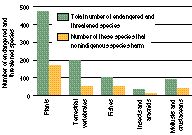
Nonindigenous species do contribute to a significant proportion of listings of threatened and endangered species in the United States; about 315 native species and subspecies listings are attributed, at least in part, to nonindigenous species (Fig. 6). Based on U.S. Fish and Wildlife Service Federal Register listing documents for endangered and threatened species, nonindigenous species have contributed to the decline of approximately 35% of listed taxa. One-third of the 35% of the listed taxa affected by nonindigenous species are from island ecosystems, primarily Hawaii and Puerto Rico. Although island taxa seem to be more susceptible to the adverse effects of nonindigenous species, the mainland biota is far from immune.
|
Fig. 6. Number of United States species listed under provisions of the U.S. Endangered Species Act of 1973 (U.S. Fish and Wildlife Service 1994) whose status is attributed to threats from nonindigenous species (Office of Technology Assessment 1993; updated by present authors through 1995). |
Freshwater ecosystems are similar to islands because they are surrounded by land. Aquatic organisms, like island species, are especially vulnerable to the effects of nonindigenous species--in fresh water such effects have been magnified by widespread habitat disturbance.
|
|
|
| |
|
|
|
One hundred fishes were on the U.S. Fish and Wildlife Service list of endangered and threatened species as of 20 August 1994; nonindigenous species contributed to the decline of 49. Of the 30 extinct fishes in the United States, nonindigenous species were a factor in the extinction process of 24. Nonindigenous species involved in the extinction of fishes included the parasitic sea lamprey, mosquitofish (see box on Eastern and Western Mosquitofishes), trouts, sunfishes, and basses. The mechanism of extinction varied from predation and competition for food and space to genetic swamping through hybridization (Miller et al. 1989).
|
|
|
The effects of nonindigenous fishes on endangered species and aquatic biodiversity will probably significantly increase during the next 25 years because of the drastic increase in introduced fishes during the past 45 years. Analysis of more than 12,000 records of introduced fishes reveals that between 1831, the date of the first known release of nonindigenous fishes, and 1950, a period of 120 years, fewer than 117 known fish species were introduced. Between 1950 and 1995, a span of only 45 years, more than 458 additional fish species were introduced. Introductions of nonindigenous fishes were made in all states, but were most numerous in California, Florida, Hawaii, Colorado, and Texas (Fig. 7).
|
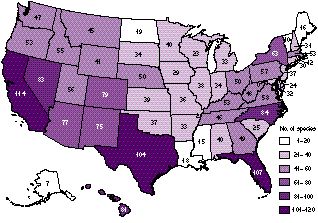
Fig. 7. Number of nonindigenous fish species introduced into inland waters of the United States, 18501995 (data are from the U.S. Geological Survey, Florida Caribbean Science Center, Gainesville, Florida, March 1995). |
Nonindigenous fishes originate from a variety of locations. Intentional introductions have been made by management agencies as part of game or forage fish stocking. In addition, many game fishes were illegally stocked by well-intentioned but misguided anglers (U.S. Geological Survey, Florida Caribbean Science Center, Nonindigenous Fishes Database, Gainesville, Florida). Several species, such as grass carp, were widely introduced for biological control of aquatic plants, many of which were also introduced (Schmitz 1994). Aquarium fishes represent another group of nonindigenous fishes that are now found in many habitats. Although many of these fishes escaped from fish-culture facilities, more were released by aquarists (Fig. 8). The tropical origin of most aquarium fishes limited their distribution to the extreme southern portion of the nation or to thermal springs in colder areas (Courtenay et al. 1984).
|
|
|
Native fishes throughout the desert Southwest are in serious jeopardy from nonindigenous fishes (Minckley and Deacon 1991; also see Southwest chapter). This region, characterized by low native fish richness and high endemism, has received the most fish introductions and suffered the greatest loss of native fishes. Species such as the bonytail chub and razorback sucker, which inhabit large rivers in the Colorado River basin, and the Sonoran topminnow and several pupfishes and springfishes, inhabitants of small desert springs, are directly threatened by numerous predaceous nonindigenous fishes.
|

Fig. 8. The jaguar guapote (top) and the oscar are two nonindigenous fish species that were either released by aquarists or escaped from aquarists into Florida waters. The jaguar guapote is likely to spread while the oscar, now considered a game fish, has already spread throughout southern Florida (U.S. Geological Survey, Florida Caribbean Science Center, unpublished information).
© R. T. Bryant |
Of the approximately 300 freshwater mussels found in the United States, about 73% are considered imperiled (Williams et al. 1993). Scientists believe that two nonindigenous bivalve mollusks, Asian clams and zebra mussels, have contributed to the decline of native mussels (Ricciardi et al. 1995). Asian clams, the most widespread nonindigenous mollusks in the United States, entered the west coast in the 1930's and invaded the southeastern United States in the 1950's (McMahon 1983). In some areas, Asian clams carpet stream bottoms, reaching densities of several thousand individuals per square meter (J. D. Williams, U.S. Geological Survey, Florida Caribbean Science Center, Gainesville, Florida, personal observations).
|

|
Nonindigenous plants also threaten endangered species; for example, the endangered snail kite has difficulty feeding when its waters are covered by invasive nonindigenous plants such as water hyacinth (Sykes 1987), and the nesting of endangered sea turtles is hampered by growth of Australian-pines (National Research Council 1990).
|
|
|
Economic Consequences of Successful Nonindigenous Species |
|
Examples of the economic cost of introductions of nonindigenous species can be found in every state and in a wide range of terrestrial, freshwater, and saltwater habitats. Of the more than 6,500 nonindigenous taxa in the United States, about 15% are considered economically or ecologically harmful. In the United States, documented economic losses from only 79 taxa during this century are estimated conservatively at $97 billion, and this figure does not include many costly agricultural weeds with little or no economic loss data (Office of Technology Assessment 1993).
|
|
|
The thousands of established nonindigenous species in the United States that are not known to have caused ecological and economic damage to date should not be viewed as benign biota but as potential biological time bombs. For example, purple loosestrife existed in low numbers for more than a century before populations exploded, displacing valuable native wetland plants. Every year, more than 190,000 hectares of wetlands are taken over by this invasive nonindigenous plant (Thompson et al. 1987). Purple loosestrife is typical of nonindigenous species that eventually become an economic liability after existing at low population levels or in geographically limited areas for decades and then undergoing explosive growth and expansion of range.
|
|
|
One of the most costly unintentional introductions, the zebra mussel, arrived in United States waters via ballast water of cargo ships. Since its detection in the Great Lakes in 1988, the zebra mussel has already caused economic damage to Great Lakes industries. The anticipated costs to the power industry during the next 10 years exceed $3 billion (Office of Technology Assessment 1993). The assignment of a cost in dollars to the severe alteration of aquatic ecosystem structure and function and the local extirpation of native species is more difficult, however. The economic cost of species extinction and ecosystem alteration is generally not included in the cost of invasive nonindigenous species unless a commercial commodity is lost. Also, loss of nonconsumptive uses of a resource is usually not included in the cost of nonindigenous species. For example, if a forest is destroyed by a nonindigenous insect or pathogen, the damage to timber is calculated in assessing cost, but the loss of nonconsumptive uses of forests--hiking, camping, bird watching, photography--is usually ignored.
|
|
|
Beyond direct economic cost from the loss of a product, human health is at risk from some nonindigenous species. Imported red fire ants, an unintentional introduction, arrived in the southern United States at Mobile, Alabama, in dry ship ballast, in the early 1940's (Office of Technology Assessment 1993). Fire ant stings are painful and can produce a severe allergic reaction that requires hospitalization and which is sometimes fatal (Fig. 9). Some nonindigenous plants also present health hazards; for example, Brazilian pepper (Fig. 10) produces allergens that cause contact dermatitis and respiratory difficulty in many people. Likewise, the blood fluke planorb, an introduced aquatic snail, which is established in Florida and Texas, is the required intermediate host for human blood flukes that cause the debilitating disease schistosomiasis (Office of Technology Assessment 1993). If blood-fluke disease becomes established in the United States, it will be a major human health problem in Florida and Texas where the intermediate host snail became established.
|
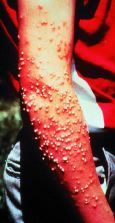
Fig. 9. Reaction to imported red fire ant stings on the arm of a teenager.
Courtesy U.S. Department of Agriculture |
Africanized honey bees also represent a threat to human health and the economy in the southern United States (Frank 1994). Queens of African honey bees were brought from Africa to Brazil in 1956 to increase commercial honey production. Since their initial introduction, these honey bees have spread north through Central America and Mexico; they invaded Texas by 1990 and Arizona by 1993. More than 2,000 human deaths and immeasurable loss of livestock, especially horses, have been attributed to stings of Africanized honey bees since their introduction into Brazil. In Texas, more than 200 serious stinging incidents and one death have been reported since 1990 (Frank 1994). Economic threats from the aggressive Africanized honey bees will come from their effects on tourism and agriculture. The most severe economic impact is expected in Florida, where Africanized honey bees are expected to occupy the entire state (Frank 1994).
|

Fig. 10. Brazilian pepper, a nonindigenous pest species in south and central Florida, has multistem growth habits (top); its flowering (center) and fruiting foliage (bottom) cause skin irritation and respiratory problems in many people.
a. |
Beekeepers have found that management of Africanized honey-bee colonies is more difficult because of several traits, most notably extremely defensive stinging. This resulted in serious setbacks of the beekeeping industry as the Africanized honey bees spread north through Brazil and Central America. In the United States, Africanized honey bees are expected to compete for food and to hybridize with the managed European honey bee. Managed European honey bees are an important agricultural commodity, used nationwide for crop pollination, at an estimated annual value of $9 to $19 billion. The estimated value of crops in Florida that depend on honey-bee pollination is $1.5 billion. Each year, thousands of Florida honey-bee colonies are shipped as far as Maine and North Dakota to pollinate crops (Frank 1994).
|
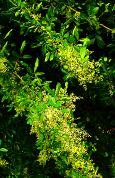
b. |
| |
|
|
|
Federal Laws About Invasive Nonindigenous Species |
|
Before the early 1900's, there were no laws concerning nonindigenous species, and decisions about these introductions were made by individuals or agencies with little or no examination of their possible effects. After experiencing the economic and ecological damage of some early introductions, federal legislation (Table 6) requiring more formal review obviously was required to prevent future problems. Federal legislators sought to improve the screening of introductions, but the patchwork of laws has numerous gaps. Federal laws (Library of Congress 1972; Office of Technology Assessment 1993) generally address specific incidents, providing a remedy for only a small fraction of the problem. Although these laws have prevented some ill-conceived intentional and unintentional introductions, the process is imperfect and represents little more than a token response to the problem.
|
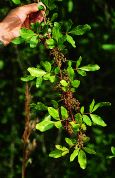
c. |
|
Federal laws (Library of Congress 1972) for formal review with structured methods--for example, protocol and decision models, economic benefitcost analysis, and risk assessment--are needed for screening nonindigenous species, including biological-control agents, before introduction. Although protocols exist for the evaluation of intentional introductions of some groups of organisms, these lack enforceability except when adopted by law, which is rarely the case (Welcomme 1986; Carlton 1989). For example, a protocol and decision model for evaluating proposed introductions of fishes was proposed by Kohler and Stanley (1984) and further refined by Kohler and Courtenay (1986). This model consists of five levels of review, each level requiring a more stringent evaluation of the proposed fish introduction. Although this model was adopted by the American Fisheries Society, it has been used rarely (perhaps fewer than five times) during the past 20 years and is not required by any state or federal law. |
Table 6. Federal laws prohibiting or restricting introduction and movement of nonindigenous species.
| Federal laws |
| Lacy Act (1900) |
Strengthens and supports state wildlife conservation laws and promotes agricultural and horticultural interests by prohibiting importation of injurious wildlife |
| Plant Quarantine Act (1912) |
Regulates imports or interstate shipments of plants or their parts and propagules to prevent introduction of plant diseases and insect pests |
| National Park Service Organic Act (1916) |
Promotes the eradication and control of nonindigenous species and prohibits most introductions in national parks |
| Federal Seed Act (1939) |
Authorizes U.S. Department of Agriculture to set standards for seed purity and to reduce the interstate movement and importation of nonindigenous plants |
| Public Health Services Act (1944) |
Regulates entry of living organisms that may carry or cause human diseases |
| Federal Insecticide, Fungicide and Rodenticide Act (1947) |
Controls movement of nonindigenous microbes into and through the United States |
| Importation of Certain Mollusks (1951) |
Provides for the inspection and treatment of goods entering the United States from areas infested with any terrestrial or freshwater mollusks to control entry of such organisms |
| Department of Agriculture Organic Act (1956) |
Animal and Plant Health Inspection Service is authorized to conduct an eradication program in countries adjacent to or near the United States |
| Federal Plant Pest Act (1957) |
Restricts agricultural pests (pathogens, noxious weeds, animal and plant pests) from importation and interstate movements |
| Federal Noxious Weed Act (1974) |
Provides program support to control undesirable plants on federal lands |
| Executive Order 11987 Exotic Organisms (1977) |
Restricts the introduction of exotic species into natural ecosystems under federal agency authority |
| Cooperative Forestry Assistance Act (1978) |
U.S. Forest Service is responsible for detecting, identifying, surveying, and controlling forest pests |
| Agricultural Quarantine Enforcement Act (1989) |
Prohibits shipping of plants, fruits, and vegetables via first-class mail |
| Food, Agriculture, Conservation and Trade Act (1990) |
Genetic Resources Program--purpose is to collect, classify, preserve, and disseminate genetic material important to agriculture |
| Great Lakes Fish and Wildlife Restoration Act (1990) |
Controls the sea lamprey |
| Toxic Substances Control Act (1990) |
Enables the Environmental Protection Agency to regulate nonindigenous microbes |
| Nonindigenous Aquatic Nuisance Prevention and Control Act (1990) |
Controls and reduces the spread of aquatic pest species |
|
|
| | |
Future Direction of the Nonindigenous Species Issue
|
To meet the challenge of established nonindigenous species and future introductions of nonindigenous species requires policy development, enforcement, education, and research. The most critical need is in the area of policy development and enforcement, supported by aggressive public awareness and educational campaigns. Public awareness of the ecological, economic, and health risks from nonindigenous species is essential to successful implementation of policy and enforcement.
|
Existing legislation on nonindigenous species is fragmented, reductionist, and lacks comprehensive coverage and policy philosophy. Research is needed into how best to develop a policy, what it should look like, and how it could be enforced. At this point, prevention of further introductions of invasive nonindigenous species is unquestionably the most prudent policy, one that could save billions of dollars in damage as well as prevent extensive perturbations to native ecosystems and endangered species. How such policy should be framed remains to be seen, but it needs to be developed by interdisciplinary thinkers who understand potential biological, social, and economic problems and limitations.
|
Research should also be conducted on ecosystem effects of invasive nonindigenous species, as well as on economic fallout from ecosystem changes. Humans receive many free ecosystem services from nature, such as pollination of agricultural crops, development and protection of soils, oxygen production and purification of air, water filtration, coastal protection by wetlands, and production of food resources in estuaries. How these services have been affected by invasive nonindigenous species is largely undocumented, as is how the services will continue in the face of disruptions by invasive nonindigenous species.
|
Implementation of a nonindigenous species policy demands a firm scientific basis, which will require the acquisition of information not currently available. Our knowledge of biology, physiology, ecology, and behavior of most nonindigenous species is rudimentary at best. Compilation and analysis of information on chronology of introductions, their pathways, and their rates and modes of dispersal are essential to the development of policy for nonindigenous species. Research in these areas is critical to understanding the nature of biological invasions and how to prevent or limit their effects.
|
|
|
| |
Authors
James D. Williams
U.S. Geological Survey
Biological Resources Division
Florida Caribbean Science Center
7920 N.W. 71st Street
Gainesville, Florida 32653
Gary K. Meffe
Savannah River Ecology Laboratory
Drawer E
Aiken, South Carolina 29802
|
References
|













